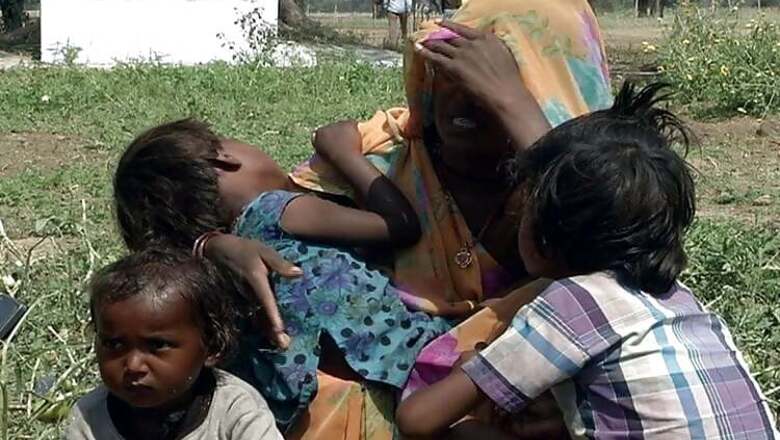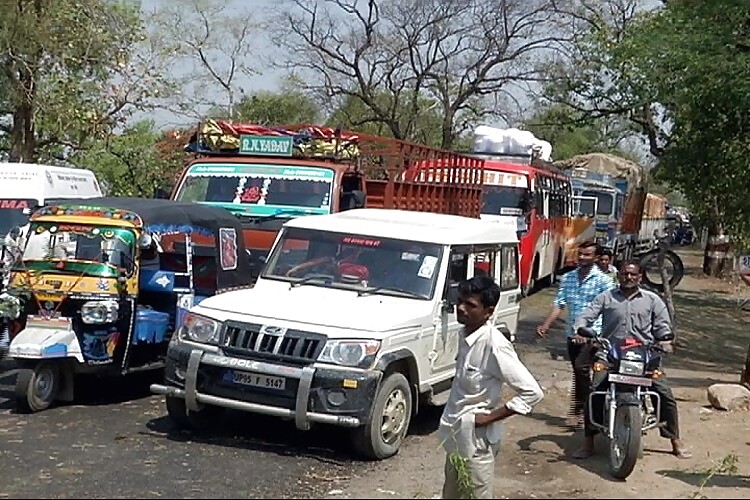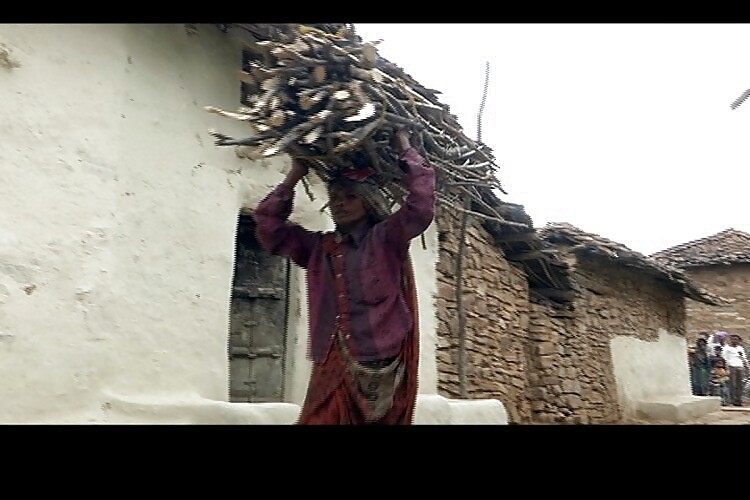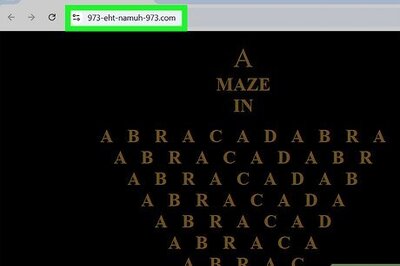
views
On the road from Banda to Chhatarpur near Basaura village hundreds of farmers are protesting after a hailstorm damaged their crop.
They block the road and don't allow four wheelers and bigger vehicles to pass through. As the car can't go through, one is forced to pillion ride on a motorcycle to get to the fields and see the damage.
The anger is not surprising at all as one travels through the villages and visits people's homes in Bundelkhand. But the sheer despair is hard to stomach.
"Hailstorm destroyed everything. Now we are getting compensation for last year's (2015) damage. Officials say pay Rs 3000 to get the compensation. 100% of the crop has been destroyed," says Gram Pradhan Jaikaran Rajput.

A woman Ram Kali tried to hang herself using a rope. Fortunately, her husband discovered her in the nick of time and her life has been saved. Acres upon acres of crop have been destroyed due to untimely hailstorm and villagers say no food was cooked in any of the homes on the day of the hailstorm.
ALSO READ: Lakhs migrate from Bundelkhand without any dream or money
Ram Kali had borrowed around Rs 60,000 to tend to her tomato crop. In about the fortnight the tomatoes would have started reddening. But the hailstorm destroyed the entire crop. She won't even get any compensation because she doesn't own the land she had invested in with such hope.
"Hailstorm destroyed the crop. I spent Rs 60,000 and now I don't have any money left with me. The rope I tried to hang myself with is kept there. I spent all the money on the crop and did not even give a proper meal to the children," she says.
ALSO READ: Famine-hit Bundelkhand in distress; chapati-salt becomes the staple food
"I was distraught. Their father would have looked after them. Where will I get the money from, how will I feed them," she adds looking towards her children

But Ghanshyam Rajput, who owns 9 bighas (about 7 acres) of land will get some relief. The hailstorm has destroyed part of his wheat, chana and lahi. But the extent of loss will be known only after a government survey. According to the new norms even if 33% of his crop is damaged he stands to get Rs 13,000 per hectare and by the time the promised compensation reaches him, months, if not a year would have passed.
One of his and his wife Kusuma's main worries is how to keep their son Sevan in the private school he goes to. For now the school is letting the bright kid study without paying the fees.
"We dug wells, we did not employ labour, did not use electricity and now all is lost. My daughter is expecting. What will I give her," asks Kusuma Rajput.
Mahoba District Magistrate Veereshwar Singh says the government gives Rs 6,800 for non irrigated land, Rs 13,500 for irrigated land. The amount is fixed. It cannot compensate for the entire loss but the government gives a fixed rate."
Rain fed agriculture is very risky business. In 2015 after facing more than 40% rainfall deficit, Uttar Pradesh had declared 50 of the 75 districts drought hit and sought Rs 2058 crore in assistance from the Centre. But the state received Rs 1304 crore. But 2016 is the second consecutive year of poor rain.

In 2014, 44 districts were drought hit. While there is little to show on the ground as relief or systemic solutions the Samajwadi Party government that runs Uttar Pradesh is advertising it's compassion for farmers and blaming the centre. Uttar Pradesh will elect a new Assembly in 2017.
The state government is organising Samajwadi Diwas where songs praising the Akhilesh yadav regime are being played. It lists out government interventions for people in the drought-hit region.
The state government has suspended loan recovery for six months and is aggressively pushing the MNREGS. It is also implementing the National Food Security Act since January ahead of schedule where every family member that has a PDS card gets 5 kilo of rice or wheat per month.
While it is true that there is rice or wheat in many of the households, it is also true that there is little else. Chronic hunger is a fact that even district officials acknowledge.

Banda ADM Dr. S Pandya says, "In my district there is no village were MNREGS is not implemented. Almost 40 to 45,000 people are working in MNREGS. But they don't get enough protein and vitamin. It has been a bad three years. There is not enough work."
The drought is not just the failure of the monsoons; it is also because of the failure to conserve water when it does rain.
Baghein river is so dry that one can walk on the river bed. People are cultivating their crop and and there is also an illegal brick kiln. While it rained in Banda for two days, the river is not even being given a chance.
Children also play cricket on the river bed. There is a dry patch of land which used to be the Ken canal. One can only tell it is a canal from the bridge over it
A local resident Puja Diwedi says, "I have lived here all my life and have never never see this so dry. There is no water even for animals. It is so dry that there is no moisture in it."
At first glance it looks like miles upon miles of greenery in the middle of a horrific drought. But it is actually the bed of the Khauf pond spread over 1700 acres. Now it is so dry that people are using it to cultivate potato, tomato and other vegetables.
Chhattarpur has declared a drought for the first time in four years. The dry Khauf pond, which also is a source for water for the Chhattarpur town, has sp`elt doom for the Rackwar community who depend on it for fish farming.
A fisherman Santosh Rackwar shows us his fishing nets that have not been used this season. "It takes two years for fish to mature. BUt it has all failed this year."
"Well, those used to fishing will not take to MNREGS. Labour migration is the biggest problem. We have created 10,0000 mandays in the first three months and 85% of people are covered under the food security scheme," claims Chhatarpur CDO Chandra Mohan Thakur.

The UPA-I government's Bundelkhand Package of Rs 7266 crore was announced with much fanfare in 2009. Divided between Uttar Pradesh and Madhya Pradesh, the money was meant to dig wells, create water conservation projects and build market yards. It was ambitious but like most large scale deployment of government resources it was also plagued by corruption.
"We filed many FIRs. When it came to big projects there was a lot of corruption. You can claim that we fought corruption but then the focus was derailed. We do not see the impact. Micro interventions yielded good results," says Thakur
"Market yards were opened, but there is nothing to sell. Wells that were constructed are dry because water tables have gone down. Now we are digging deeper to find water," says Mahoba District Magistrate Veereshwar Singh.
Taking note of the widespread agrarian crisis Prime Minister Narendra Modi announced the Fasal Bima Yojana (Crop Insurance Scheme) where farmers will have to pay 2% interest on Kharif and 1.5% on Rabi, But it is expected to be implemented only after April 2016 in Banda.

Rural bank officers say official circulars haven't reached them yet. However, the NDA government's zero balance accounts is making a difference. Allahabad Rural Bank, Narendra Kumar Gupta says, "We have just read about it in the papers, let us see how it works."
A local resident says, "We send money through the account opened under the prime minister's scheme."
Back to back droughts have broken the backbone of the agrarian economy in Bundelkhand.
Local people point out that the impact of one drought can be felt for the next three years. The MNREGA and the NFSA, even though imperfectly implemented have made a difference. But the same can't be said of the 2009 Bundelkhand package.




















Comments
0 comment